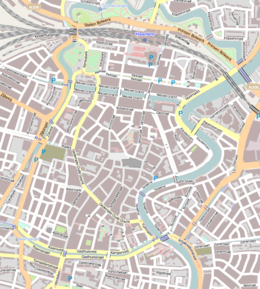- Museum De Hallen, Haarlem
-
Museum De Hallen is the name of the exhibition space on the Grote Markt, Haarlem, the Netherlands, where modern and contemporary art is on display in alternating presentations. The emphasis is on contemporary photograph and video presentations, with the focus on Man and society. As an organisation, De Hallen falls under the Frans Hals Museum.
De Hallen consists of three different buildings, the Vleeshal (Flesher's hall) on the east side and the Verweyhal (named for Kees Verwey) on the west side are two large "halls" sandwiching the small entrance building. All three buildings are National Heritage sites today.[1]
Contents
De Vleeshal building
Museum De Hallen forms a block of 3 buildings on the south side of the Grote Markt, HaarlemThe Vleeshal was built in the years 1602 to 1605 and was originally a ‘meat hall’ where butchers sold their goods.[1] The heads of bulls and rams on the façades are reminders of the original function of the building. It was considered one of the sites to see in Haarlem in the 1911 encyclopedia Britannica:
“ In the great market place in the centre of the city are gathered together the larger number of the most interesting buildings, including the quaint old Fleshers' Hall, built by Lieven de Key in 1603, and now containing the archives;[2] the town hall; the old Stadsdoelen, where the burgesses met in arms; the Groote Kerk, or Great Church; and the statue erected in 1856 to Laurens Janszoon Koster, the printer. ” —Encyclopedia Brittanica article on Haarlem, 1911, [3]
De Vleeshal is an excellent example of the Dutch renaissance, with renaissance ornaments being applied on a basic Gothic structure (floor plan and outer walls). The renaissance forms include pilasters, rustica, Tuscan (interior) pillars, scrollwork (above the cellar entrances) and obelisks. Sample prints by Hans Vredeman de Vries from Antwerp provided a source of inspiration for this.
De Vleeshal was built by Lieven de Key, the town architect, commissioned by the city government, which judging by the finished building had a substantial treasury at the time.[1] It remained a meat hall all the way into the 19th century.
The building later fulfilled a totally different function; from 1840 to 1885 it served as a storehouse for a garrison quartered in Haarlem. Later the building served as a Public Records Office, and after that as a depot for the municipal library. During the Second World War the building was occupied by the Distribution Service.
After WWII, the Mayor and Aldermen decreed that the building should become an exhibition hall, and it has remained so until today. The Frans Hals Museum organises alternating exhibitions of contemporary art on two storeys, and the Archeological Museum is in the cellar.
Verweyhal building
The Verweyhal is next to the Vleeshal on the Grote Markt in Haarlem. The little ‘fish house’ in between – once the home of the servant of the fish market – serves as the entrance for both Halls. The Verweyhal was built in the 19th century as a gentlemen’s society of the former drama society, later a cultural social club, Trou moet Blycken.[1]
In the second half of the 19th century the earlier building of the drama society, which was on the same spot, was too small. In 1876 the society held a competition for a new design. The Amsterdam architect A.J. van Beek won, and his plan was carried out.[1] The building was occupied in 1880. Almost simultaneously, the gentleman's society had financial problems. Perhaps the building was a bit too prestigious. The gentlemen initially tried to alleviate the situation by raising their membership contribution. That hardly helped, because the number of members declined. As the increased contribution did not solve the problem, the ground floor was rented out as a shop. This did not help either, and ultimately the gentlemen were forced to sell the building to the city, which became the new owner for 125,000 guilders.
The society building was converted in 1924 into the Spaarnebank. The safe was on the ground floor; offices were set up on the first floor.
More renovations were carried out in 1978. Since then, the first floor houses the Department of Cultural Affairs, the Planning Authority and the City Architect.
Fourteen years later, in 1992, the building was renovated again. With support from the Kees Verwey Foundation, the first floor received a new name: the Verweyhal. The former city architect Wiek Röling made a design for the new layout together with architect Jan Bernard. Today, the Verweyhal still has a museological function. The Frans Hals Museum displays its collection of modern art and organises contemporary art exhibitions (especially photography focused on man and society).
The building is in the neoclassical style: this was very popular at the end of the 19th century, but later fell out of fashion. In the first half of the 20th century, the building received a great deal of criticism. It was considered much too large and pompous. ‘An object of general contempt,’ according to the description of the distinguished gentlemen’s society. The building was called ‘an unsuccessful box of blocks’ in 1947 by the engineer G. Friedhoff, who wanted to demolish the building and replace it with traditional façades. Opinions about the building changed in the 1970s, and for the first time, words of praise were heard. Today, the building is an official monument.

Dutch Rijksmonument 19262 
Dutch Rijksmonument 513378 
Dutch Rijksmonument 19261 References
- ^ a b c d e Rijksmonument report
- ^ In 1911 the Vleeshal contained the archives; These have since moved to the Janskerk (Haarlem) and the Vleeshal today is in use by two museums; the Archeologisch Museum Haarlem and Museum De Hallen, Haarlem.
- ^ "Article on Haarlem". Encyclopedia Brittanica, 1911. January 2011. http://www.1911encyclopedia.org/Haarlem.
External links
Categories:- Art museums and galleries in the Netherlands
- Museums in Haarlem
- Rijksmonuments in Haarlem
Wikimedia Foundation. 2010.





